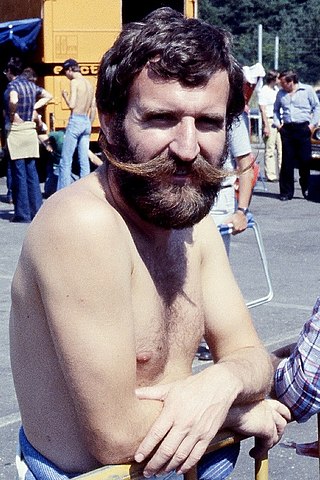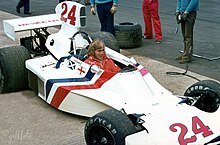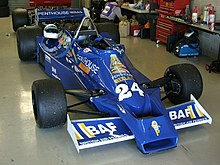
James Simon Wallis Hunt was a British racing driver who won the Formula One World Championship in 1976. After retiring from racing in 1979, Hunt became a media commentator and businessman.
The Tyrrell Racing Organisation was an auto racing team and Formula One constructor founded by Ken Tyrrell (1924–2001) which started racing in 1958 and started building its own cars in 1970. The team experienced its greatest success in the early 1970s, when it won three Drivers' Championships and one Constructors' Championship with Jackie Stewart. The team never reached such heights again, although it continued to win races through the 1970s and into the early 1980s, taking the final win for the Ford Cosworth DFV engine at Detroit in 1983. The team was bought by British American Tobacco in 1997 and completed its final season as Tyrrell in 1998. Tyrrell's legacy continues in Formula One as the Mercedes-AMG F1 team, who is Tyrrell's descendant through various sales and rebrandings via BAR, Honda and Brawn GP.

The 1975 Austrian Grand Prix was a Formula One motor race held at Österreichring on 17 August 1975. It was race 12 of 14 in both the 1975 World Championship of Drivers and the 1975 International Cup for Formula One Manufacturers. It was the eighth Austrian Grand Prix and the sixth to be held at the Österreichring. It was held over 29 of the scheduled 54 laps of the six kilometre circuit for a race distance of 171 kilometres. The race was shortened by heavy rain, meaning that only half points were awarded. The weekend itself was marred by the deaths of Mark Donohue and a track marshal in a practice crash.

The 1977 British Grand Prix was a Formula One motor race held at Silverstone on 16 July 1977. It was the tenth race of the 1977 World Championship of F1 Drivers and the 1977 International Cup for F1 Constructors.

Harald Ertl was an Austrian racing driver and motorsport journalist. He was born in Zell am See and attended the same school as Grand Prix drivers Jochen Rindt, Helmut Marko and Niki Lauda.

Kauhsen was a Formula One constructor from Germany, founded by former sportscar driver Willi Kauhsen. The team started in Formula Two in 1976, purchasing Renault cars, and raced with an assortment of drivers with limited success. Kauhsen then entered the 1979 Formula One season, spending 1978 designing their own chassis with Cosworth engines. They participated in two World Championship Grands Prix with Gianfranco Brancatelli, failing to qualify on both occasions, before the team was shut down.
Lyncar was a Formula One constructor from the United Kingdom. They participated in only two grands prix, the 1974 and 1975 British Grands Prix, entering a total of two cars.

Team Rebaque was a Mexican Formula One entrant and constructor, based in Leamington Spa, UK. They participated in 30 Grands Prix, initially entering cars bought from Team Lotus, before finally building a car of their own. The Rebaque HR100 was entered for the team's final three races before the team's closure. The team qualified to race on 19 occasions, and achieved one World Constructors' Championship point with its best finish of sixth at the 1978 German Grand Prix.

Harvey Ernest Postlethwaite was a British engineer and Technical Director of several Formula One teams during the 1970s, 1980s and 1990s. He died of a heart attack in Spain while supervising the testing of the aborted Honda F1 project.

Team Lotus was the motorsport sister company of English sports car manufacturer Lotus Cars. The team ran cars in many motorsport categories including Formula One, Formula Two, Formula Ford, Formula Junior, IndyCar, and sports car racing. More than ten years after its last race, Team Lotus remained one of the most successful racing teams of all time, winning seven Formula One Constructors' titles, six Drivers' Championships, and the Indianapolis 500 in the United States between 1962 and 1978. Under the direction of founder and chief designer Colin Chapman, Lotus was responsible for many innovative and experimental developments in critical motorsport, in both technical and commercial arenas.

Frank Williams Racing Cars was a British Formula One team and constructor.

The McLaren M23 was a Formula One racing car designed by Gordon Coppuck, with input from John Barnard, and built by the McLaren team. It was a development of the McLaren M16 Indianapolis 500 car. A Ford Cosworth DFV engine was used, which was prepared by specialist tuning company Nicholson-McLaren Engines. This helped push the DFV's horsepower output to around 490 bhp.

The Brabham BT49 is a Formula One racing car designed by South African Gordon Murray for the British Brabham team. The BT49 competed in the 1979 to 1982 Formula One World Championships and was used by Brazilian driver Nelson Piquet to win his first World Championship in 1981.

The Hesketh 308 and its derived sister model the 308B are Formula One racing cars designed by Harvey Postlethwaite for Hesketh Racing to compete in the 1974 and 1975 World Championships. The car gave James Hunt his first World Championship Grand Prix win in the 1975 Dutch Grand Prix at Zandvoort.

The Wolf WR7 was a Formula One car built for the 1979 season by the Walter Wolf Racing team. Three examples of the car were produced. The first was WR7. A second car, WR8, was built to the same specification, while a slightly modified car, WR9, first appeared at the British Grand Prix. The cars were driven by 1976 champion James Hunt and Keke Rosberg. The engine was a Ford Cosworth DFV.
Gérard Ducarouge was a French Formula One car designer whose career in motorsport started in 1965 when he joined the French constructor and racing team Equipe Matra Sports. He designed the Matra MS80 car which, entered by the British privateer Matra International team of Ken Tyrrell, won both the World Drivers' Championship and World Constructors' Championship in the 1969 season. After leaving Matra he also designed cars for Ligier and Lotus which won several races in the 1970s and 1980s.

The Hesketh 308D is a Formula One racing car built by the Hesketh Racing team in 1976. The car was based on the Hesketh 308 originally designed by Harvey Postlethwaite, and was powered by a 3-litre V8 Ford Cosworth DFV engine.
Walter Wolf Racing was a Formula One constructor active from 1977 to 1979, which won the first race the team entered. It was owned and run by Canadian Walter Wolf. The team was based in Reading, UK but raced with the Canadian licence.

The Hesketh 308C was a Formula One racing car designed by Harvey Postlethwaite and used by Hesketh Racing in the latter stages of the 1975 Formula One season. The car featured the rubber suspension which Postlethwaite had pioneered on the preceding 308B model and a Ford-Cosworth DFV engine. In 1976, the car was acquired by Wolf–Williams Racing and rebranded as the Wolf–Williams FW05.
Colin Crabbe Racing, also known as Colin Crabbe - Antique Automobiles and Antique Automobiles Racing Team, was a privateer team run by Colin Crabbe, a noted dealer in historic racing cars, that entered a single car in 17 Formula One races in 1969 and 1970. Vic Elford and Ronnie Peterson drove for the team, the cars used being a Cooper T86, a McLaren M7B and a March 701.



















